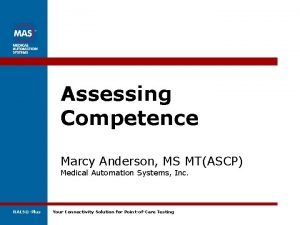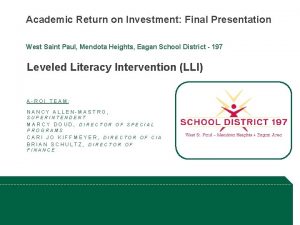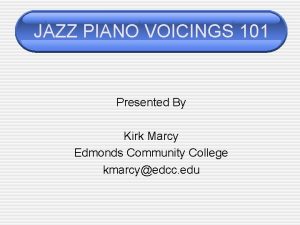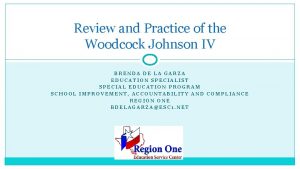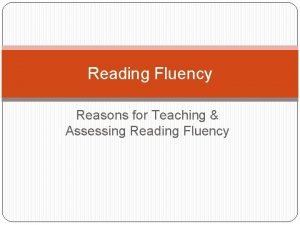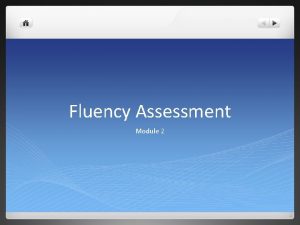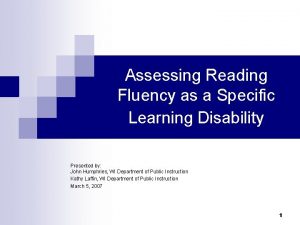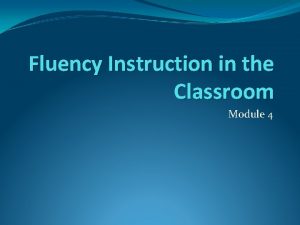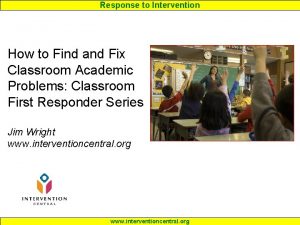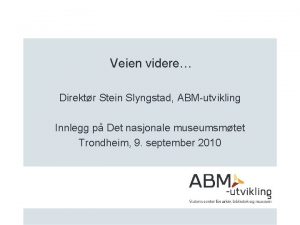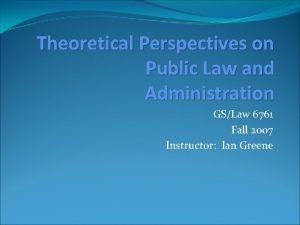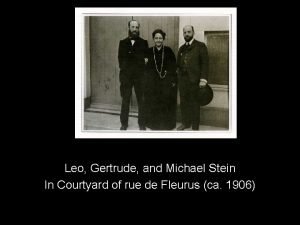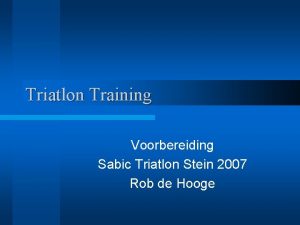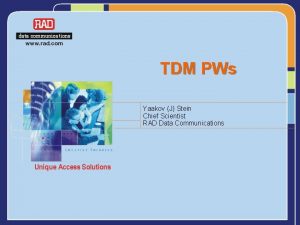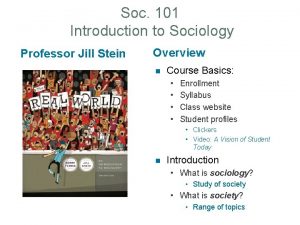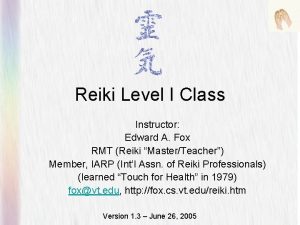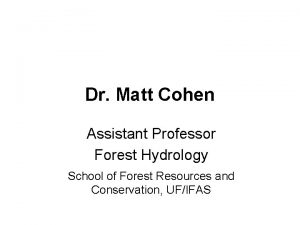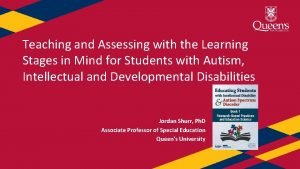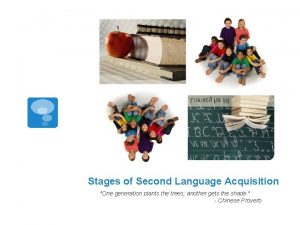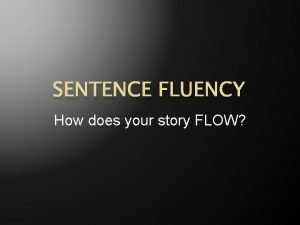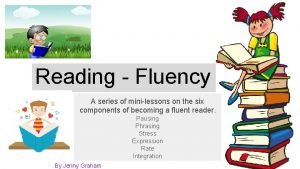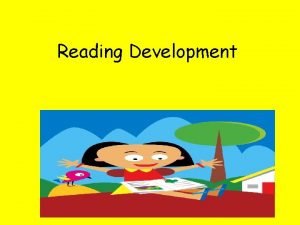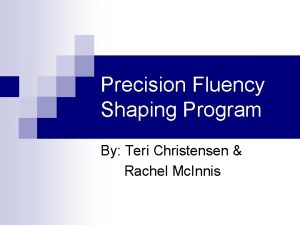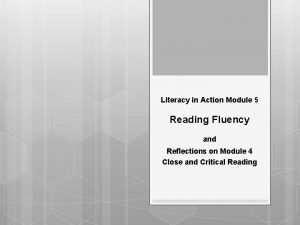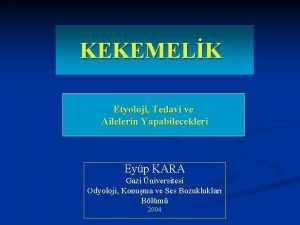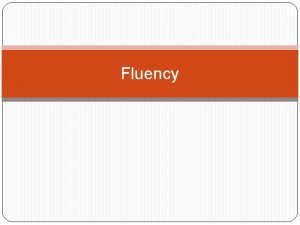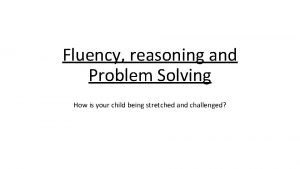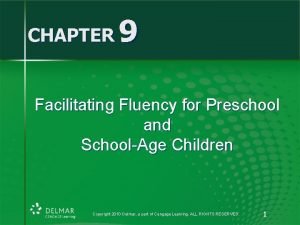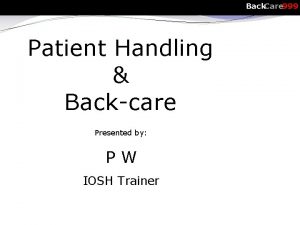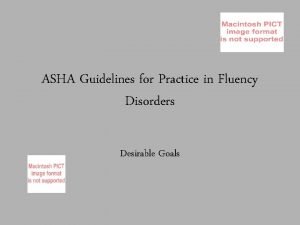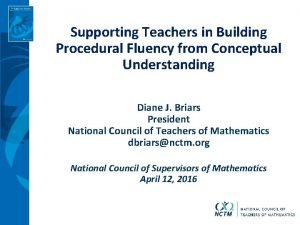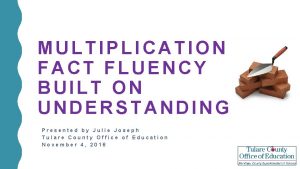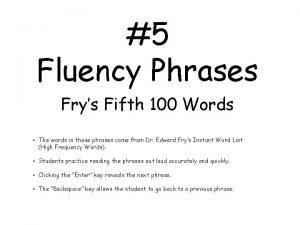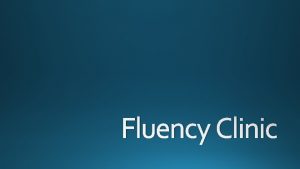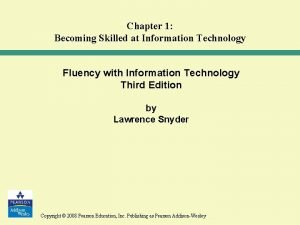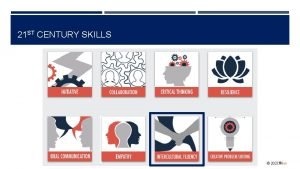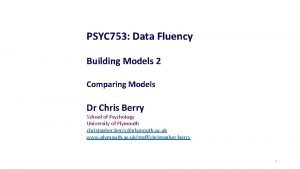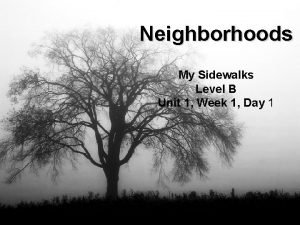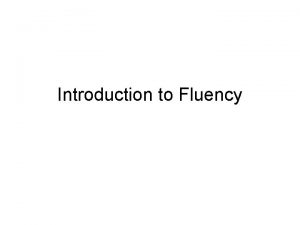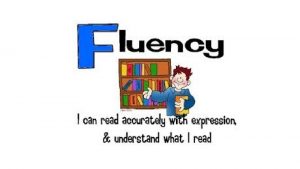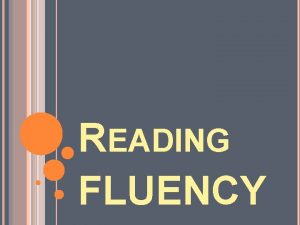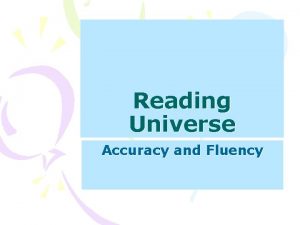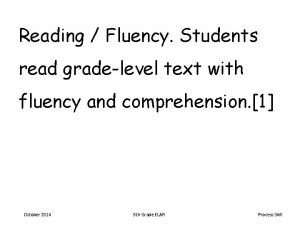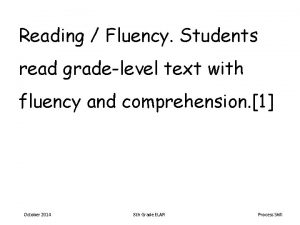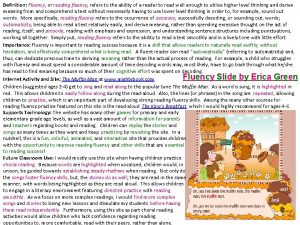Reading Fluency Marcy Stein Ph D University of



































































- Slides: 67

Reading Fluency Marcy Stein, Ph. D. University of Washington, Tacoma

Outline l l l Fluency Definitions Research Support for Building Fluency Building: Instructional Methods Fluency Building: Monitoring Fluency Progress Books and Programs References and Websites

Fluency Definitions Fluency as Assessment Reading Fluency Interventions

Fluency as Assessment l Curriculum-Based Measurement (CBM) is a set of standard simple, short-duration fluency measures of reading, spelling, written expression, and mathematics computation. l “One-Minute Timings”

Fluency as Assessment l Purpose of CBM: Progress Monitoring § Student performance is assessed continuously during instruction. § Decisions are made about whether student progress is satisfactory or not. § DIBELS, AIMSWEB

Defining Fluency “Fluency is the ability to read a text quickly, accurately, and with proper expression. ” National Reading Panel, 2000

Defining Fluency “Fluency is the ability to read a text accurately and quickly. When fluent readers read silently, they recognize words automatically. They group words quickly in ways that help them gain meaning from what they read. Fluent readers read aloud effortlessly and with expression. Their reading sounds natural, as if they are speaking. ” Put Reading First, 2001

Defining Fluency “Fluency is the ability to read with sufficient ease and accuracy that one can focus attention on the meaning and message of text. ” Adams, 2002

Factors Contributing to Fluency Reading Speed FLUENCY Prosody Accuracy

Defining Accuracy Independent level (95%-100% accuracy) l Instructional level (90%-94% accuracy) l Frustration level (<90% accuracy) l

Defining Reading Speed Words Correct Per Minute (WCPM) l Grade-level norms l § Set goals. § Determine students with high needs.

Norms for Oral Reading Fluency Grades 2 -5 Grade 2 3 4 5 Percentile Fall WCPM Winter WCPM Spring WCPM 75 82 106 124 50 53 78 94 25 23 46 65 75 107 123 142 50 79 93 114 25 65 70 87 75 125 133 143 50 99 112 118 25 72 89 92 75 126 143 151 50 105 118 128 25 77 93 100 WCPM = words correct per minute Hasbrouck & Tindal, 1992

Defining Prosody “The compilation of spoken language features that includes stress or emphasis, pitch variations, intonation, reading rate, and pausing. ” Osborn & Lehr, 2003

Research Support for Building Fluency and Reading Comprehension

Theory of Automaticity More Fluent Readers direct relatively little effort to the act of reading, allowing them to focus active attention on meaning and message. l Less Fluent Readers must direct considerable effort to the act of reading, leaving little attention for reflecting on its meaning and message. l Foorman & Mehta, 2002; Samuels, 2002

Theory of Automaticity Less fluent readers need to allocate more resources to decoding More fluent readers have more resources available for comprehension

Fluency and Reading Comprehension Oral reading fluency was more closely related to reading comprehension (as measured by a standardized test) than to word recognition of words drawn from the oral reading passage. Fuchs, & Maxwell, 1988

Fluency and Reading Comprehension

NAEP Oral Reading Fluency Scale Level 4: Reads primarily in larger, meaningful phrase groups. Although some regressions, repetitions, and deviations from text may be present, these do not appear to detract from the overall structure of the story. Preservation of the author's syntax is consistent. Some or most of the story is read with expressive interpretation. Level 3: Reads primarily in three- or four-word phrase groups. Some smaller groupings may be present. However, the majority of phrasing seems appropriate and preserves the syntax of the author. Little or no expressive interpretation is present. Level 2: Reads primarily in two-word phrases with some three- or four-word groupings. Some word-by-word reading may be present. Word groupings may seem awkward and unrelated to larger context of sentence or passage. Level 1: Reads primarily word-by-word. Occasional two-word or three-word phrases may occur-but these are infrequent and/or they do not preserve meaningful syntax. http: //nces. ed. gov/pubs 95/web/95762. asp Source: U. S. Department of Education, National Center for Education Statistics. Listening to Children Read Aloud, 15. Washington, DC: 1995

NAEP 4 th-Grade Oral Reading Study Nonfluent Fluency Level 1 Fluency Level 2 Fluency Level 3 Fluency Level 4 Percent Accuracy 94 94 96 97 Words per Minute 65 89 126 162 http: //nces. ed. gov/pubs 95/web/95762. asp Source: U. S. Department of Education, National Center for Education Statistics. Listening to Children Read Aloud, 15. Washington, DC: 1995

Oral vs. Silent Reading “Most of the evidence cited to support independent silent reading comes from correlational rather than experimental research. ” National Reading Panel, 2000

Oral vs. Silent Reading “Of the few experimental studies on the effects of independent reading, most have found small or no gains in reading achievement as a result of such activity. ” Osborn & Lehr, 2003

So… What Works? Guided, Oral, Repeated Reading

Fluency Building: Instructional Methods

Building Reading Fluency Model fluent reading, then have students reread the text on their own. l Provide guided, oral, repeated reading practice. l § § § student-adult reading (parent, tutor, paraeducator) partner reading (small group, class-wide) tape-assisted reading computer-assisted reader’s theater Osborn & Lehr, 2003 Put Reading First, 2001 Rasinski, 2003

Guided, Oral, Repeated Reading l Guided § benefits from feedback § feedback from peers or adults l Oral § student engagement l Repeated • three or more repetitions or to specified criterion • motivating activity

Repeated Reading: Student-Adult Significantly increases reading rate, accuracy, and comprehension l Works with older students as well as elementary children l Fosters fluent word recognition through multiple exposures to words l

Repeated Reading: Student-Adult l Direct students to reread a relatively short passage (50 -200 words) until: § a predetermined level of fluency is attained, or § the text has been read 3 -5 times.

Repeated Reading: Partner Reading Before using partner reading for repeated reading, do the following: 1. Designate reading partners. 2. Select appropriate reading materials. 3. Assemble materials. 4. Implement the program.

Step 1: Designate Partners Rank order students according to results of survey-level assessment. b. Split the list in half to form pairs. c. Pair top-ranked reader of the higherperforming half with top-ranked reader of the lower-performing half; do the same for the two students who are second on each list and so on until all students are paired. a.

Step 2: Select Reading Materials Identify materials appropriate for the lower reader’s instructional reading level (90%-94% accuracy). b. Have both partners read the same passage from the same material. c. Have enough materials selected for two new passages per week. a.

Step 3: Assemble Materials l What Teachers Need § timing device § list of partner pairings § description of partner roles l What Students Need § reading partner § reading material § folder

Step 4: Implement Partner Reading The stronger reads aloud; this models fluent reading. l The less fluent reader reads aloud the SAME text for the same length of time. l After both partners have read, one partner asks the other to: l § identify the sequence of the key ideas. § tell the main idea.

Tape-Assisted Reading l Purpose: To give students support and a sense of the proper phrasing and speed of fluent reading. l The student: § listens to text read at 80 -100 wpm by a fluent reader and follows along by pointing to the text. § reads aloud in sync with tape subvocalizing the words. § reads same text independently following repeated reading procedures.

Computer-Assisted Reading www. readingassistant. com

Reader’s Theater Use of scripts (plays, poetry, expository text) l No costumes, props, or scenery l Multiple opportunities for meaningful practice l

Reader’s Theater Weekly Activities Select or write a script (see Resources) l Monday: Introduce activity; assign parts. l Tuesday-Thursday: Have students practice. l Friday: Have students perform. l Rasinski, 2003

Fitting It In before school l during school l § lunch § recess § school-wide reading time l after school

Getting Kids on the Ball Basketball-loving Tacoma students get a reading on educational priorities The News Tribune, 1/21/2004 Andre Stout and Trevor Wong coach youth basketball at the North Tacoma Boys & Girls Club

The tutors time the students as they read passages written for various grade levels, marking on a sheet how many words they read in one minute. The News Tribune, 1/21/2004

After each reading, tutors help them with words they find difficult. The children read each passage three times before moving on to another. The News Tribune, 1/21/2004

“The teachers tell you this stuff works in class, and you’re like, ‘yeah, ’” Wong said. “Then you come out here and see it. You’re like, ‘Wow. ’” The News Tribune, 1/21/2004

Guided, Oral, Repeated Reading Two essential features: l Opportunities for Practice l Guidance and Feedback

Monitoring Fluency Progress Graphing Fluency Progress Making Instructional Decisions Determining WCPM

Graphing Fluency Progress Adult Monitoring (teacher, paraeducator, tutor) l Student Self-Monitoring As part of a repeated reading program, the student may record the wcpm of their first “cold” reading on a graph. On each subsequent reading, the student records the increase in fluency. l

© 2004, Pearson Education, Inc. Quick. Reads

Making Instructional Decisions Determine Annual Goals Begin with the median score (middle) of baseline (approximately three assessments) l Calculate wcpm for each remaining week l § Grades 1 -2: 2 to 3 words per week § Grades 3 -5: 1 to 2 words per week l If a 1 st-grader reads 25 wcpm today… § how many wcpm should s/he read next week? 27 -28 § in 5 weeks? 35 -40 § in 10 weeks? 45 -55

Corrective Reading Individual Reading Progress Chart © 1999, SRA/Mc. Grawl-Hill. Decoding B 1: Lessons 12 -35

Determining WCPM = Total Words Read – Errors l Scored as Correct § Mispronunciations/Word § Repetitions Substitutions § Omissions § Hesitations § Reversals § Self-Corrections’ § Insertions § Dialect/Articulation l Special Cases § Numerals § Hyphenated Words § Abbreviations

Practice Activity Monitoring Reading Fluency

Books & Programs

www. scholastic. com

http: //www. prel. org/programs/rel/fluency. asp

http: //www. readnaturally. com/

Read Naturally Masters Edition (ME) Steps 1. Select Story. The student selects a story from the packet at the correct reading level and gets the cassette or audio CD for the story. 2. Read Along—Key Words: The student reads the key words and definitions with the recording. 3. Prediction: The student writes a sentence using the title, picture, and key words to predict what the story will say about the topic. 4. Cold Timing: The student times himself/herself for one minute, orally reading the selected story for the first time and underlining unknown words. 5. Graph in Blue: The student graphs the number of words read correctly in one minute. 6. Read Along: The student reads the story three times, tracking and subvocalizing, with the recording. 7. Practice: The student practices reading the story without the audio tape several times until able to read at the predetermined goal rate. Students time each practice. 8. Answer Questions: The student answers the questions about the story.

Read Naturally Masters Edition (ME) Steps 9. Pass Story: The teacher times the student for one minute on the story, subtracts the errors, and determines if the student has reached the goal. To pass, the student must also make less than three errors, read with good expression, and answer the comprehension questions correctly. 10. Graph in Red: The student graphs the number of words read correctly in the oneminute timing. The student marks the same bar of the graph used in step 4. 11. Retell/Word List: The student writes a retell of the story either writing a specific number of ideas from a story or writing for a specific amount of time. In the phonics levels, the student practices the word list until s/he is able to read a predetermined number of words in one minute. Repeat. Begin a New Story: The student repeats steps 1 -10 with a new story. Adjust Goals/Levels: After the student completes 12 stories in a level, consider adjusting the student's goal or level. http: //www. readnaturally. com/how-steps. htm

www. pearsonlearning. com



http: //www. greatleaps. com/

www. sopriswest. com

Conclusion Fluency is important because it is related to reading comprehension. l Reading fluency can be developed by engaging students in guided, oral, repeated reading activities. l Monitoring student progress in reading fluency: l § can be motivating to students. § is useful in setting instructional goals.

References & Websites

References Adams, M. J. (2002, November). The promise of speech recognition. Power. Point presentation at A Focus on Fluency Forum, San Francisco, CA. Available at http: // www. prel. org/programs/rel/fluency/Adams. ppt Armbruster, B. B. , Lehr, F. , & Osborn, J. (2001). Put reading first: The research building blocks for teaching children to read. Jessup, MD: National Institute for Literacy. Chard, D. J. , Vaughn, S. & Tyler, B. J. (In press). A synthesis of research on effective interventions for building reading fluency with elementary students with learning disabilities. Journal of Learning Disabilities. Dowhower, S. L. (1989). Repeated reading: Research into practice. The Reading Teacher, 42, 502 -507. Foorman, B. R. , & Mehta, P. (2002, November). Power. Point presentation at A Focus on Fluency Forum, San Francisco, CA. Available at http: //www. prel. org/programs/rel/fluency/Foorman. ppt Fuchs, L. S. , Fuchs, D. , & Maxwell, L. (1988). The validity of informal reading comprehension measures. Remedial and Special Education, 9 (2), 20 -28.

References Hasbrouck, J. E. , & Tindal, G. (1992). Curriculum-based oral reading fluency norms for students in grades 2 through 5. Teaching Exceptional Children, 24, 41 -44. National Reading Panel. (2000). Report of the National Reading Panel: Teaching children to read. Bethesda, MD: National Institute of Child Health and Human Development. Osborn, J. , Lehr, F. , & Hiebert, E. (2003). A focus on fluency. Honolulu, HI: Regional Educational Laboratory at Pacific Resources for Education and Learning. Available online at www. prel. org/programs/rel. asp. Rasinski, T. V. (2003). The fluent reader. New York, NY: Scholastic Professional Books. Samuels, S. J. (2002). Reading fluency: Its development and assessment. In A. E. Farstrup & S. J. Samuels (Eds. ), What research has to say about reading instruction (3 rd ed. , pp. 166 -183). Newark, DE: International Reading Association.

Websites Reports on Reading http: //nces. ed. gov/pubs 95/web/95762. asp Source: U. S. Department of Education, National Center for Education Statistics. Listening to Children Read Aloud, 15. Washington, DC: 1995 A Focus on Fluency http: //www. prel. org/programs/rel. asp Put Reading First http: //www. nifl. gov/ National Reading Panel Report http: //www. nationalreadingpanel. org

Websites Professional Development http: //www. texasreading. org/utcrla/products/primary_fluency. asp Reader’s Theater Script Service – Primary grades http: //www. readers-theatre. com From Script to Stage – Grades K-8 http: //www. aaronshep. com/rt/
 Dominican university of california
Dominican university of california Marcy anderson
Marcy anderson Marcy doud
Marcy doud Marcy kirk
Marcy kirk Reading recall subtest wj-iv
Reading recall subtest wj-iv Word reading accuracy
Word reading accuracy Reading fluency checklist
Reading fluency checklist Cbm reading fluency passages
Cbm reading fluency passages Definition of reading fluency
Definition of reading fluency Fluency oriented reading instruction
Fluency oriented reading instruction Intervention central reading fluency
Intervention central reading fluency While reading activities
While reading activities Stein mart edi
Stein mart edi Direktr
Direktr Gslaw group
Gslaw group Stein jonny valstad
Stein jonny valstad Stein w. wallace
Stein w. wallace Valdis šteins
Valdis šteins Dr ariel stein
Dr ariel stein Sabic stein
Sabic stein Freiherr-vom-stein-gymnasium
Freiherr-vom-stein-gymnasium Cassandra speculative execution policy
Cassandra speculative execution policy Geologi stein mineraler fossiler og olje
Geologi stein mineraler fossiler og olje Stein frostad
Stein frostad Fedme skyldes ikke overspising
Fedme skyldes ikke overspising Stein
Stein Nicolai urban
Nicolai urban Thorwald stein
Thorwald stein Claudia stein who
Claudia stein who Prueba franny k stein el tiempo todo lo cura
Prueba franny k stein el tiempo todo lo cura Gordon stein general dynamics
Gordon stein general dynamics Stein mart edi
Stein mart edi Tdm
Tdm Jill stein sociology
Jill stein sociology Stein aerts
Stein aerts Frans stein reiki
Frans stein reiki Taylor stein uf
Taylor stein uf Ben stein iq
Ben stein iq Acquisition, fluency maintenance generalization examples
Acquisition, fluency maintenance generalization examples Speech emergence stage activities
Speech emergence stage activities What is sentence fluency
What is sentence fluency Six dimensions of fluency rubric
Six dimensions of fluency rubric In the poem watch me grow to what is reading compared
In the poem watch me grow to what is reading compared Precision fluency shaping program
Precision fluency shaping program Choral reading examples
Choral reading examples Fluency shaping tekniği
Fluency shaping tekniği Intercultural fluency
Intercultural fluency Functional fluency
Functional fluency Fluency with information technology
Fluency with information technology Fluency def
Fluency def Problem reasoning
Problem reasoning Fluency friday
Fluency friday Preschool fluency activities
Preschool fluency activities Mnemonic fluency manual handling
Mnemonic fluency manual handling Fluency shaping techniques asha
Fluency shaping techniques asha Procedural fluency examples
Procedural fluency examples Building fact fluency graham fletcher
Building fact fluency graham fletcher Fry's fluency phrases
Fry's fluency phrases Fluency rules program
Fluency rules program Solution fluency
Solution fluency Computational fluency
Computational fluency Information technology fluency
Information technology fluency Dibels first sound fluency
Dibels first sound fluency Fun with fluency
Fun with fluency Intercultural fluency
Intercultural fluency Non fluency features
Non fluency features Data fluency
Data fluency My sidewalks level b unit 2 week 3 comprehension test
My sidewalks level b unit 2 week 3 comprehension test

